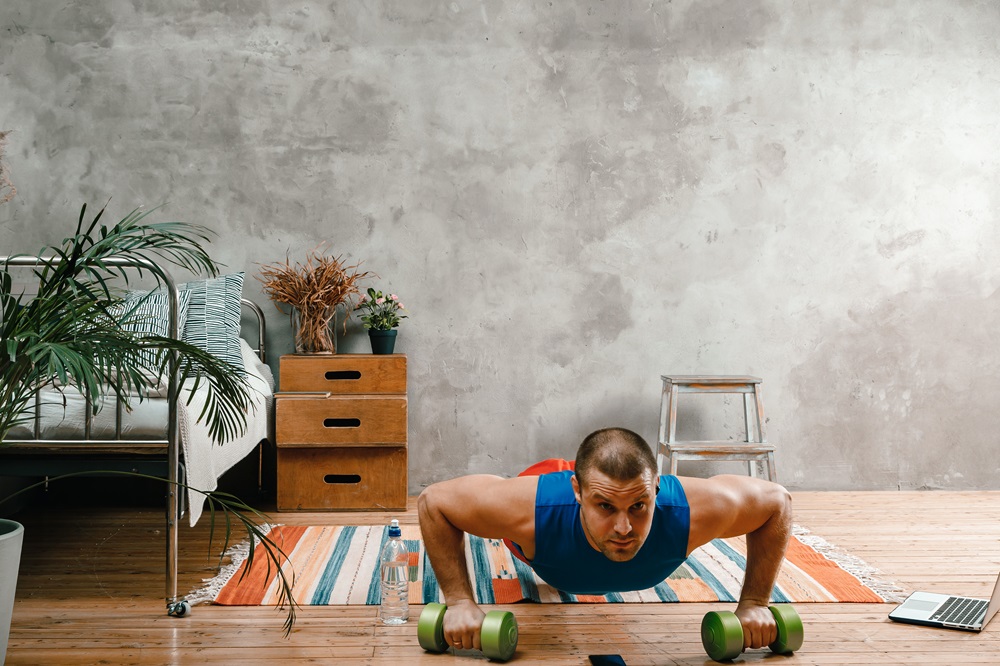Shoulder Exercises at Home – How to Strengthen Your Shoulders Without a Gym?

Shoulder exercises at home can be done by both women and men. Training the shoulders at home can strengthen the deltoid muscles, help relieve back pain, and improve the overall appearance of your physique. What are the best shoulder exercises to do at home? Is it possible to train shoulders without any equipment? Why is it worth working on shoulder muscles?
Table of contents
What are the shoulders? Anatomy of the shoulder muscles
The shoulders are the largest joint complex in the human body, made up of joints such as:
- the glenohumeral joint,
- the acromioclavicular joint,
- the sternoclavicular joint,
- the scapulothoracic joint.
Within the shoulder girdle, the muscles include:
- the deltoid muscle,
- the trapezius muscle,
- the rhomboid muscle,
- the levator scapulae muscle,
- the serratus anterior muscle,
- the pectoralis minor muscle,
- the subclavius muscle,
- the rotator cuff muscles - supraspinatus, infraspinatus, teres minor, subscapularis.
The shoulder muscles perform many essential functions necessary for proper body mechanics. They stabilize the scapula, allow its rotation, and enable adduction and abduction of the arms, as well as external and internal rotation of the upper arm.
Most often, “shoulders” refers to the deltoid muscles, considered the largest in the upper limb girdle. However, shoulder training can also engage other muscles of the shoulder complex.
Why it’s worth training shoulders at home
Shoulder training can improve the athletic appearance of the body while strengthening the deltoid muscles and increasing muscle strength.
Shoulder exercises can be beneficial not only for athletes and active people who want well-built arms and a V-shaped torso but also for anyone wanting better mobility and the ability to raise arms overhead without difficulty—for example, to reach something from a high shelf. Strong shoulders can also help reduce the risk of injuries to the shoulder girdle.
Regular shoulder workouts can be especially useful for people who work in a seated position, such as at a computer, helping reduce muscle tension and relieve back pain.
How to perform shoulder training at home
Keeping shoulder muscles in good condition is key to maintaining overall body function. Since shoulders are prone to injury, it’s important to warm up properly before training. Afterward, it’s worth doing stretching exercises—especially targeting the muscles that worked the hardest during the workout.
When training shoulders, focus on proper technique rather than the number of repetitions. It’s best to start with bodyweight exercises and gradually increase difficulty by adding resistance.
Track your progress and set small goals to stay motivated and adjust your exercises to your needs.
Best bodyweight shoulder exercises
You can train your shoulders at home without any additional equipment, using only your body weight. With proper form, you can achieve great results and improve your body proportions. Here are some bodyweight shoulder exercises worth trying:
- Push-ups - Lie face down and place your hands shoulder-width apart on the floor. Rest on your toes, inhale, and push your body up until your arms are straight, keeping your body aligned. Exhale as you lower yourself by bending your elbows. Keep your pelvis and spine stable. Push-ups work the pectoralis major and minor, as well as the front deltoid head.
- T-raise - Lie face down, extend your arms, and point your thumbs downward. Squeeze your shoulder blades together while lifting your arms off the ground. Hold for a few seconds, then lower them back. This targets the trapezius, rhomboids, and rear deltoid head.
- Crab walk - Sit on the floor, place your hands behind you, and lift your hips off the ground. Move forward and backward, keeping your chest lifted. This works the shoulders, legs, and core.
- Dips (bench dips) - Find a stable surface, such as a chair. Support your weight on your hands, with knees slightly bent. Lower and raise your body using only your arms. This works the deltoids, pectoralis major, and triceps.
Effective shoulder exercises at home with equipment
You can also train shoulders at home using equipment such as dumbbells, a barbell, or resistance bands, which can make your workouts more effective and help you see results faster. Beginners without equipment can use water bottles as weights.
The weight, repetitions, and sets should match your fitness level. Shoulder training should be challenging but safe to avoid strain. Here are some effective options:
- Lateral raises with dumbbells - Stand upright with feet shoulder-width apart, holding dumbbells at your sides. Exhale as you lift your arms to shoulder height, keeping a 90-degree angle with your torso. Inhale as you lower them back down. This works the deltoids and also engages the trapezius and rotator cuff muscles.
- Seated dumbbell press - Sit on a chair with feet apart and back straight. Hold dumbbells at shoulder height with an overhand grip. Inhale as you press them overhead in a triangular motion, bringing them closer together at the top. Exhale as you lower them back. This targets the front deltoid head, trapezius, and triceps.
- Overhead arm passes with a miniband - Place the miniband between your hands. Kneel, bend your elbows, and hold the band at chest level, keeping tension. Inhale as you raise your arms, bend them behind your head, exhale, then return to the start. This works the deltoids effectively.
- Overhead press with a resistance band - Place the band under your feet, holding it at collarbone height with an overhand grip. Inhale as you press upward, exhale at the top, and inhale again as you return. Keep your core and glutes engaged. Choose a band that provides resistance but still allows full range of motion. This targets the front deltoids and also works the pectoralis major and triceps.

